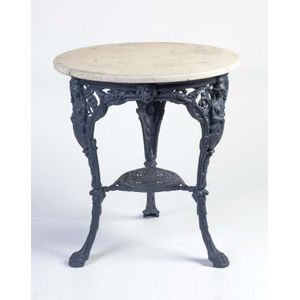Blue Grey Floral Carved French Occasional Table
You must be a subscriber, and be logged in to view price and dealer details.
Subscribe Now to view actual auction price for this item
When you subscribe, you have the option of setting the currency in which to display prices to $Au, $US, $NZ or Stg.
- Husk Motif - The husk motif is a decorative element that has been used in furniture, silver, glass and ceramics decoration for centuries. The motif is typically based on the shape of the husk, or outer covering, of a nut or seed. It is often depicted as a series of overlapping, scalloped shells that create a textured, ornamental pattern.
In furniture, the husk motif is commonly used in the design of chair and table legs, as well as in the decoration of cabinet doors and drawer fronts. The motif is carved into the wood or other material, creating a three-dimensional effect that adds depth and visual interest to the piece.
In ceramics, the husk motif is used in a variety of ways, from the decoration of bowls and plates to the design of decorative tiles and other objects. The motif is often painted or carved into the surface of the clay, creating a relief pattern that adds texture and dimensionality to the piece.
The husk motif has been used in many different historical and cultural contexts, from ancient Greece and Rome to 18th-century France and England. It has been adapted and modified over time, with variations including the acanthus leaf and the palmette motif. - Floral Swag / Garland / Festoon - Floral swags are a decorative motif often used in the ornamentation of various objects, such as silverware, glassware, and furniture. The term "swag" refers to a garland or wreath of flowers, foliage, or other decorative elements, which is usually arranged in a loop or curve.
Floral swags can be found in a variety of decorative styles, from ornate Baroque and Rococo designs to more naturalistic Art Nouveau and Art Deco styles. They are often used to add a touch of elegance, refinement, or whimsy to an object, and can be seen on a range of items from chandeliers and candlesticks to picture frames and tea sets.
In the decoration of silver objects, floral swags are often used to accentuate the curves and lines of the piece, and to add visual interest to the surface. Similarly, on glass objects, floral swags may be used to frame or highlight a particular area of the object, or to add a touch of color and delicacy.
On furniture, floral swags can be found on a variety of pieces, from cabinets and armoires to chairs and sofas. They are often used to enhance the lines and curves of the furniture, and can be used to create a sense of movement and flow in the design.
Overall, floral swags are a versatile decorative element that can be adapted to a range of styles and applications, and have been used in the decoration of various objects throughout history. - Apron - A decorative wooden panel that sits underneath the top surface of a table or chair, and unites the top of the piece with the legs, running at right angles to the underside. On carcase furniture such as a chest or wardrobe, the apron sits below the drawers or doors and attaches to the legs.
On carcase furniture without legs the panel under the drawers or doors sits on the floor and is termed a plinth.
An apron can provide a decorative touch to an otherwise unadorned piece of furniture and at the same time provide structural support and strength. They can be carved or pierced and quite elaborate. - Circa - A Latin term meaning 'about', often used in the antique trade to give an approximate date for the piece, usually considered to be five years on either side of the circa year. Thus, circa 1900 means the piece was made about 1900, probably between 1895 and 1905. The expression is sometimes abbreviated to c.1900.
This item has been included into following indexes:
Visually similar items

A French 19th century walnut occasional table, the yellow inset marble top, above a frieze carved with foliate on fluted tapering legs with carved stretcher. 80 cm high, 100 cm wide, 60 cm deep

Fine antique French marble topped oval salon table, approx 97 cm high, 82 cm wide

A finely carved walnut marble topped circular table by Maison Krieger, Paris, circa 1890, 76 cm high, 86 cm diameter

An English Britannia pub table, 19th century, cast iron with marble top, 72 cm high, 65 cm diameter. Provenance: Property of a Gentleman, Melbourne
